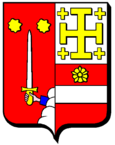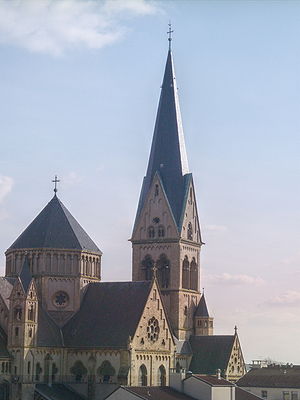Montigny-lès-Metz
| Montigny-lès-Metz | ||
|---|---|---|

|
|
|
| region | Grand Est | |
| Department | Moselle | |
| Arrondissement | Metz | |
| Canton | Montigny-lès-Metz (main town) | |
| Community association | Metz Métropole | |
| Coordinates | 49 ° 6 ' N , 6 ° 9' E | |
| height | 165-190 m | |
| surface | 6.70 km 2 | |
| Residents | 21,819 (January 1, 2017) | |
| Population density | 3,257 inhabitants / km 2 | |
| Post Code | 57950 | |
| INSEE code | 57480 | |
| Website | Montigny-lès-Metz | |
 Catholic parish church of St. Joseph by Ludwig Becker |
||
Montigny-lès-Metz (German: Montigny near Metz, from 1915 to 1918 Monteningen , from 1940 to 1944 Montenich ) is a French commune in the Moselle department in the Grand Est region (until 2015 Lorraine ). With 21,819 inhabitants (as of January 1, 2017), Montigny is the third largest of the 730 municipalities in the Moselle department after Metz and Thionville . The inhabitants call themselves Montigniens .
geography
The municipality of Montigny-lès-Metz is located immediately southwest of Metz . The old town center is to the right of the Moselle , the south-west adjoining district of Saint-Privat is separated from the town center by the Metz-Nancy railway line. Montigny, which forms a closed settlement area together with other surrounding communities and the city of Metz, has the character of a residential town in the countryside.
history
The origin of the name Montigny probably comes from two Latin words: "Mons" (mountain) and "ignis" (fire). From this it is concluded that this "mountain of fire", this "burning height" was so called by the Celtic Gauls , because they used heights to burn signal fires in order to correspond from one village to another.
From 1915 to 1918 Montigny carried the Germanized name Monteningen , which with its -ingen ending incorrectly suggests a later Franconian establishment ( Franconian land grab ). The German place name was then adapted between 1940 and 1944. The new place name Montenich with its "-ich ending" (cf. Jülich , Zülpich , Sinzig , Merzig ) should remind of an earlier Celtic or Gallo-Roman foundation.
On September 10, 1940, Montigny-lès-Metz was founded together with the Metz surrounding communities Longeville-lès-Metz, Le Ban-Saint-Martin, Saint-Julien-lès-Metz, Vallières, Borny, La Maxe, Magny, Moulins, Plappeville, Scy-Chazelles, Sainte-Ruffine and Woippy were incorporated into the municipal area of Metz in order to compensate for the population loss caused by the war and to make Metz a major city .
coat of arms
The coat of arms was awarded to Montigny by the Prefect of the Moselle Department on July 28, 1949.
Blazon : The coat of arms is divided into three parts. Heraldically on the right, a blue-clad right arm protrudes from a silver-colored cloud on a red background, in whose hand a silver sword with a gold grip is held upright. The edge of the sword is flanked by two golden stones. Heraldically on the top left is a golden Jerusalem cross on a white background . Heraldically on the lower left is a horizontal silver band on a red background. A golden rose appears on a red background above the silver band.
Explanation: The three parts of the coat of arms represent the medieval history of Montigny:
- In the Middle Ages, Montigny was subordinate to the Bishop of Metz . The two golden stones commemorate the main patron of the diocese of Metz, Saint Stephen , who was the first martyr of Christianity to be stoned. The hand with the sword refers to the martyr's death by beheading the apostle Paulus von Tarsus , the second patron of the diocese of Metz and the patron saint of the Metz cathedral chapter . The red background symbolizes the blood of the two martyrs shed for the faith.
- Since the Knights Templar had possessions in Montigny that passed to the Johanniter after its suppression in 1312 , both orders of the Crusaders are represented in the coat of arms by the Jerusalem cross. The Jerusalem cross was first used as a coat of arms by the crusader Godfried von Bouillon in 1099 . He had been Duke of Lower Lorraine since 1089 and one of the leaders of the first crusade . Gottfried founded the Kingdom of Jerusalem and, as its regent, bore the title “Protector of the Holy Sepulcher”. He made the coat of arms of the Duchy of Bouillon , the Belgian cross with four additional Greek crosses , the symbol and national coat of arms of the Kingdom of Jerusalem.
- The lords of Waibelskirchen , who temporarily ruled, are represented with their coat of arms, the silver band on a red background with a rose.
The lower tip of the coat of arms is sometimes supplemented by the order "Croix de guerre 1939-1945" (War Cross 1939-1945). This coat of arms supplement was awarded to Montigny on November 11, 1948 by the French Defense Minister.
Population development
| year | 1962 | 1968 | 1975 | 1982 | 1990 | 1999 | 2007 | 2015 |
| Residents | 22,388 | 24,520 | 24,519 | 22,114 | 21,983 | 23,426 | 22,585 | 21,430 |
Culture and sights
Personalities
- Joseph Alois Bach (1838–1912), former papal Zouave officer , ennobled Commander of the Order of Pius, lived and died here; he was buried in the community cemetery
- Emil Felden (1874–1959), German Protestant theologian and writer
- Walter Königsdorfer (1907-2006), German lawyer and politician (CSU)
- Joachim-Friedrich Lang (1899–1945), German officer in World War II
- Egon von Tresckow (1907–1952), German animator, illustrator, comic artist and caricaturist
- Johannes Mühlenkamp (1910–1986), German officer in World War II
- Kurt A. Mautz (1911–2000), German literary scholar and writer
- Wolf Ackva (1911–2000), German actor
Web links
- Community presentation (French)
Individual evidence
- ↑ a b Quelques mots d'Histoire. Montigny-lès-Metz, accessed on March 21, 2020 (French).
- ↑ Christian Fauvel: Metz 1940–1950. De la tourmente au renouveau. Metz 2017, p. 56.




